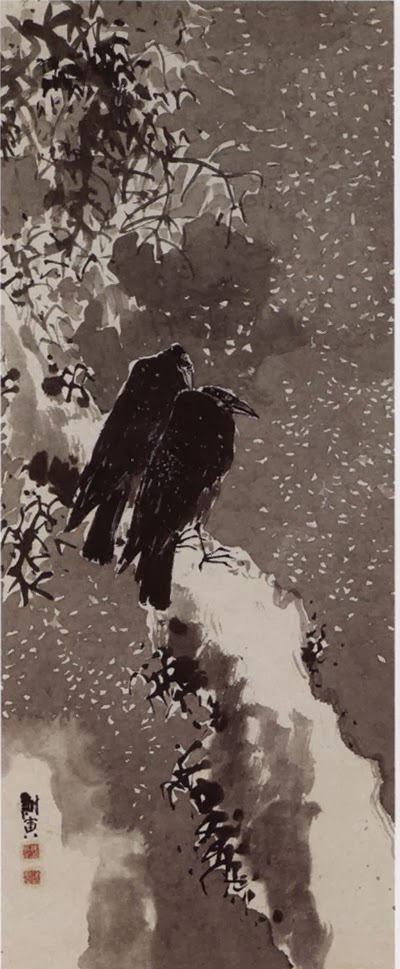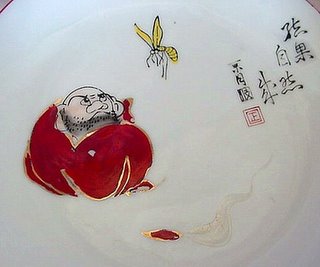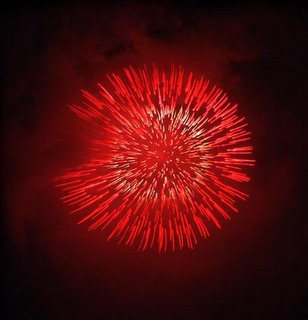[ . BACK to Worldkigo TOP . ]
:::::::::::::::::::::::::::::::::::::::::::::::::::::::::::::::::::::::::::::::::::::::::::::::::::::
Crow, Raven (karasu)
***** Location: Japan
***** Season: Non-seasonal Topic
***** Category: Animal
*****************************
Explanation
In the Japanese saijiki, the word crow (karasu) without further modification is not included, since it is with us noisily all year round.
But some compounds have seasonal references.
.. .. .. Kigo for Summer:
karasu no ko, the children of the crow, baby crow カラスの子、鴉の子
crow babies, karasu no ko 鴉の子 (からすのこ)
baby crows, ko garasu 子鴉(こがらす)
parent crows, oya garasu 親鴉(おやがらす)
karasu no su, the nest of the crow 鴉の巣 , 烏の巣
moorhen, ban, 鷭 ばん
is also called: "
River crow", kawa garasu 川烏(かわがらす)
.................................................................................
.. .. .. Kigo for Autumn:
crows leaving, wakaregarasu 別烏, 別鴉 わかれがらす
young crows leaving the nest, karasu no ko wakare 鴉の子別れ
crows in autumn, aki no karasu 秋の烏(あきのからす)
.................................................................................
.. .. .. Kigo for Late Winter:
kangarasu 寒鴉 (かんがらす) crow in the cold
..... kana, kan-a 寒鴉(かんあ)
:::::::::::::::::::::::::::::::::::::::::::::::::::::::::::::::::::::::::::::::::::::::::::::::::::::
:::::::::::::::::::::::::::::::::::::::::::::::::::::::::::::::::::::::::::::::::::::::::::::::::::::
 http://animaldiversity.ummz.umich.edu/site/resources/victor_loewen/P5083108cr.jpg/view.html
http://animaldiversity.ummz.umich.edu/site/resources/victor_loewen/P5083108cr.jpg/view.html
In our area in Western Japan, they come mostly in Autumn to feast on the kaki, the persimmons. They also swoop down in spring, when the yamataroo, a kind of large caterpillar , are descending in the millions to feed on the chestnut leaves, thus themselves becoming a delicious food for the crows. They have an elaborate network in the northern province of Okayama and know exactly where to go on the days people put out the trash in the cities (still mostly open on the curbs...) and when the local delicacies in the fields and woods are ripe.
In the
big cities, they are quite a nuisance these days, picking at the trash on the curbs and spilling it all over the place while they eat. After them come the stray cats to feed some more, then the rats to finish off the rest.
Sometimes there are so many it looks like Hitchkock and the birds around here, whith their eery crooo croo croo. They also fight with our local couple of birds of prey, the tobi 鳶、 and usually a group of them forces the tobi to seek escape by sreweing ever more high into the sky. Quite a sight to see the tobi soaring in speedy retreat.
a flock of crows is also called
. a murder of crows
Akegarasu, a crow in the morning 明けガラス
does not seem to be a kigo, as far as I could trace it in the big saijiki.
大歳時記
It should not me mixed up with
AKI no karasu, crows in autumn, see above.
Gabi Greve
Fujita Akegarasu Sensei
Fujita Akegarasu 【藤田あけ烏】(ふじた・あけがらす)
:::::::::::::::::::::::::::::::::::::::::::::::::::::::::::::::::::::::::::::::::::::::::::::::::::::
After the A-bomb was dropped on Hiroshima, the crow was associated with ill-fate or bad-fate or bad luck, foreboding future... which may keep "crow" from not being kigo in Japan.
Etsuko Yanagibori quoted by Chibi
Ravens, rooks, crows, and the like have quite a mythology associated with them in many cultures, some positive, some negative, but almost always powerful.
Chibi
http://groups.yahoo.com/group/happyhaiku/message/1213
*****************************
Worldwide use
Bhutan

The Raven Crown of the King of Bhutan
Uzha Jarog Dongchen is highly symbolic of the Bhutanese monarchy.
One day, Zhabdrung Ngawang Namgyel dreamt of a raven taking flight from his throne while lending him the power to fly with it. The raven led the Zhabdrung to Pangri Zampa, the seat of Lam Ngawang Chogyel, and entrusted him the place for the establishment of a religious centre. Later, when Zhabdrung Ngawang Namgyel fled to Bhutan at the age of 18, Yeshey Goenpo is said to have offered him the country.
MORE is here:
source : www.yanatravel.com/
:::::::::::::::::::::::::::::::::::::::::::::::::::::::::::::::::::::::::::::::::::::::::::::::::::::
Croatia
Crow
with photos
:::::::::::::::::::::::::::::::::::::::::::::::::::::::::::::::::::::::::::::::::::::::::::::::::::::
Germany
The first thing that comes to mind is the raven on the shoulder of a witch! Next is
Hans Huckebein, a raven who brings a lot of bad luck, is a famous story of Wilhlem Bush, father of the animation.

:::::::::::::::::::::::::::::::::::::::::::::::::::::::::::::::::::::::::::::::::::::::::::::::::::::
Ireland
I have often thought that the crow is the
bird of the winter -- especially in Ireland. They set out on their daily working routine before I rise -- and in the evening they come home, settle on the branches of a favourite tree or woodland, and tell each other all about it. Very ompanionable.
Crows are very much, to me, the sound of childhood, of home, of the open hills of our family farm, of the woodlands in the evening. Intelligent birds. And hard working!
Isabelle Prondzynski
:::::::::::::::::::::::::::::::::::::::::::::::::::::::::::::::::::::::::::::::::::::::::::::::::::::
Japan
The Shinto Goddess, Amaterasu is sometimes represented as a giant raven,
Yata-Garasu 八咫烏 (やたがらす).
A three-legged raven often leads pilgrims in the mountains. The mosts famous is probably the founding legend of Dewa Mountains:
The worship of Dewa-san dates from the seventh century, when an imperial prince fled to this area following the death of his father. In a vision,
a three-legged crow led him to Haguro-san (Black Wing Mountain), where he lived to the ripe old age of 90, developing his unique blend of Shinto, Buddhism and ancient folk-religion.
http://www.alpharooms.com/guide_28936.aspx
I collected some material about Black Wing Mountain,
Haguro-San 羽黒山、出羽三山
My story about more mystical things happening in this area, although not about the raven:
The Living Mummies of Northern Japan
http://fudosama.blogspot.com/2006/10/sokushinbutsu.html
In Japanese mythology, the
Karasu tengu, or minor tengu, is a supernatural being with the head and wings of a black crow. They serve Daitengu, which are fallen yamabushi (monks), tall men with big noses and red faces who can create tornadoes using fans of bird feathers they carry in their sandals.
http://www.onmarkproductions.com/html/tengu.shtml
....................
More about Raven Mythology
http://kardev.com/karasu_tengu.htm
In our neighbourhood, there is a temple, Ryoosan-Ji, where in the night of O-Bon, when the dead souls come back to visit the living, on August 14, at midnight to the light of two torches only, the
God of the Raven, karasu no kamisama 烏の神様, invades the mind of a local shaman and the man starts hopping around in the dark like a bird, sometimes for more than two hours.
It is said, if he grabs an onlooker and holds him, this person has to die within the next three years. (We have many stories about sudden deaths after such an enounter...)
I invite you to come and partake. It is one of the most spoooky matsuri festivals I have seen in Japan. And just three miles from my home.
Gabi Greve
:::::::::::::::::::::::::::::::::::::::::::::::::::::::::::::::::::::::::::::::::::::::::::::::::::::
Kenya
The best-known crow is the Indian House Crow, which has settled in Mombasa, on the Indian Ocean coast, where it has not endeared itself to the population, and is treated considerable caution...
Isabelle Prondzynski
.. .. .. .. .. .. .. .. Indian House Crow
http://web.uct.ac.za/depts/fitzpatrick/docs/r549.html
HABITAT: Entirely urban and suburban areas in s Africa, especially industrial sites and informal settlements.
GENERAL HABITS: In pairs when br, flocks up to 50 at other times.
Aggressively mobs other spp, particularly raptors16. Roosts communally in trees, arriving in flocks of up to 200. Possibly displaced from c Durban, KwaZulu-Natal by Pied Crow, but in Mombasa, Kenya, this situation reversed. Regarded as pest in Durban, where birds take food from children, kill chicks of domestic fowls, and repeatedly dive-bomb any person near the nest.
http://www.samarmagazine.org/archive/article.php?id=19
Inter-racial commentary, as the crow flies
By Paul Greenough
The Swahili word for crow is
kunguru, and there are several crow species in coastal Tanzania and Zanzibar. One of them, known in ornithology as Corvus splendens or the "house crow", is referred to in Swahili as the "Indian crow" (
kunguru wa walozi). This bird is a cynosure: everybody I spoke with in Dar es Salaam and Stonetown in Zanzibar has crow stories to tell. The bird is ubiquitous in these urban areas and invariably makes a nuisance of itself. My suggestion is simple: in complaining about "Indian house crows" Tanzanians and Zanzibaris are also complaining about Indians.
.................................Read it all here:
http://www.samarmagazine.org/archive/article.php?id=19
:::::::::::::::::::::::::::::::::::::::::::::::::::::::::::::::::::::::::::::::::::::::::::::::::::::
North America
 Corvus brachyrhynchos (American crow)
Corvus brachyrhynchos (American crow)
The common crow is widely distributed throughout the continent of North America. It breeds from British Columbia east to New Foundland, and south to southern California, Florida and the Gulf Coast. It winters north as far as southern Canada. The common crow is a partial migrant but a permanent resident in some areas.
The common crow is charcoal black in color. It is approximately 17-21 inches in length. Two other very common species within the
Corvidae family are the fish crow and the raven. The fish crow tends to be smaller than the common crow (17 inches) while the raven tends to be larger (20-27 inches). A fan shaped tail characterizes the common crow whereas the raven has a wedged shaped tail. Another feature of the common crow is its steady flapping flight, which is different from the soaring. Another difference between the crow and the raven is their calls. The common crow's call is a "caw-caw" or "caa-caa" sound, while the common raven's call is a varied, deep, guttural croaking, "wonk-wonk". The fish crow call is also unlike that of the common crow, either a nasal "kwak" or a nasal two noted "ah-ah."
The common crow is a very intelligent and adaptable creature. In a word one could describe them as opportunistic. Recent studies by ornithologists show that
crows and ravens are among the most intelligent birds, along with other members of the Corvidae. Crows gather in groups from two to eight birds in the summer, while during the winter they gather from many miles in great nocturnal roosts of up to thousands of birds. During the day they fly up to fifty miles away from these roosts in search of food. During feeding, one of two crows can be seen on high perched places serving as a lookout for the rest of the flock. These sentinels watch for signs of danger and warn the rest of the flock. This behavior allows the rest of the flock to forage more efficiently. The crow's call has varations that allow it to express warning, threats, taunting, and cheer.
Read a lot more informative things about the crow here:
http://animaldiversity.ummz.umich.edu/site/accounts/information/Corvus_brachyrhynchos.html
.............................................................................
The Western Jackdaw (Corvus monedula),
sometimes known as the Eurasian Jackdaw, European Jackdaw or simply Jackdaw, is a passerine bird in the crow family. Found across Europe, western Asia and North Africa, it is mostly resident, although northern and eastern populations migrate south in winter.
© More in the WIKIPEDIA !
 The bamboo is battered
The bamboo is battered
And the jackdaw is hungry
Cool autumn sunshine
- Shared by Res John Burman -
Joys of Japan, October 2012
:::::::::::::::::::::::::::::::::::::::::::::::::::::::::::::::::::::::::::::::::::::::::::::::::::::
Yemen
kigo for winter
on my balcony
picking herbs and a quarrel..
young crow
after the heat
the cool -
my cat talks to a crow
The sparrow
swallows a fly -
listen to crows
Heike Gewi, Yemen, January 2008
*****
YEMEN SAIJIKI
*****************************
Things found on the way
Two Gods and Three Crows of Arima 三羽烏
In olden times, the gods Onamuchi-no-Kami 大己貴命 and Sukunahikona-no-Kami 少彦名命descended to earth one day and saw three injured crows bathing in a puddle.
. Arima Tosen Shrine 有馬 湯泉神社 Toosen Jinja .
:::::::::::::::::::::::::::::::::::::::::::::::::::::::::::::::::::::::::::::::::::::::::::::::::::::
.. .. .. Raven in Mythology
Essay by Samantha Fleming
For centuries the corvids, ravens and crows in particular (corvus corax is the Latin name for the common raven and corvus corone for the carrion and hooded crows), have had a special place in the mythology of various cultures. In modern times this fascination has barely diminished. From Edgar Allen Poe's literary classic to the film of James O'Barr's cult graphic novel "The Crow", these birds still exert a powerful hold over the psyche of a significant fraction of the population. The Goths who paint their faces with white make-up and the weekend warriors who expect Raven to take them to the Otherworld to meet the dead do not see the same animal as the farmers who set up decoys in order to shoot large numbers of them every year in late spring. This is, however, typical of a creature that presents a paradox wherever one looks.
................................ Read it all here:
http://www.ravenfamily.org/nascakiyetl/obs/rav1.html
Safekeep copy:
http://groups.yahoo.com/group/Haiku-Essays/message/98
:::::::::::::::::::::::::::::::::::::::::::::::::::::::::::::::::::::::::::::::::::::::::::::::::::::
Native American Mythology : RAVEN
Famous Native American Creative Trickster God, known by many tribes under many names.
There is more to
RAVEN than meets the eye. And how many of you have met the eye of a raven? They've always been associated with Godliness. Few people know that the first bird out of Noah's ark was a raven. It just didn't return. It didn't feel the need.
ODIN relied on his two ravens to fly round the world every day and keep him informed. Edgar Allan Poe's raven shrieked 'Nevermore' but what that has to do with anything only Poe knows.

In the beginning,
RAVEN was first and foremost a Creator and Trickster God - especially of the Haida tribe who, claim he discovered the first humans hiding in a clam shell and brought them berries and salmon. A bit of a tricky God himself, he's also the long-suffering victim of arch-rival in trickery,
COYOTE. His brother
LOGOBOLA is also a bit of a tricky customer, but, despite what you may have heard, absolutely no frogs are involved. Stories about him abound.
Here's one handed down by the Tsimshian tribe...
............................................ Read it all here:
http://www.godchecker.com/pantheon/native_american-mythology.php?deity=RAVEN
:::::::::::::::::::::::::::::::::::::::::::::::::::::::::::::::::::::::::::::::::::::::::::::::::::::
......................... CORVIDOLOGY
If men had wings and bore black feathers,
few of them would be clever enough to be crows.
- Rev. Henry Ward Beecher
More lore about the Raven:
http://www.druidry.org/obod/lore/animal/raven.html
xxxxxxxxxxxxxxxxxxxxxxxxxxxxxxxxxxxxxxx
.. .. ..
Edgar Allen Poe "The Raven."
http://www.comnet.ca/~forrest/raven.html
 "Maine Ice Storm" by Jamie Wyeth
*****************************
"Maine Ice Storm" by Jamie Wyeth
*****************************
HAIKU
an early crow
flies toward the sun -
late winter morning
Gabi Greve, Jan. 17, 2005
xxxxxxxxxxxxxxxxxxxxxxxxxxxxx
the caw of a crow ...
sunshine glints from
a vibrating branch
a crow
in the spring dawn!
pieces of shell*
*the river rook, a cousin of the crow, has been known to crack open clams with river pebbles or small rocks by dropping them on the clam... it it tool use? some argue that it is a sign of intelligence?!
Chibi
http://groups.yahoo.com/group/happyhaiku/message/1213
(see below for the Raven Shell ! )
xxxxxxxxxxxxxxxxxxxxxxxxxxxxx
> > Roadside sycamore,
> > bare branches covered in crows,
> > a curious blossom.
> > Busy day at work,
> > crows returning to their roost,
> > lords of the winter.
Isabelle Prondzynski
xxxxxxxxxxxxxxxxxxxxxxxxxxxxx
drawing the raven
into itself -
evening shadow
bill k.
http://shiki1.cc.ehime-u.ac.jp/~shiki/4thconres.html
:::::::::::::::::::::::::::::::::::::::::::::::::::::::::::::::::::::::::::::::::::::::::::::::::::::
midnight
the shriek of a crow
on the graveyard
Geert Verbeke
Read more of Geert's Crow Haiku here:
http://happyhaiku.blogspot.com/2004/01/friends-geert-verbeke.html
:::::::::::::::::::::::::::::::::::::::::::::::::::::::::::::::::::::::::::::::::::::::::::::::::::::
 they end their flight
they end their flight
one by one--
crows at dusk
Yosa Buson
Shared by Isabelle Loverro
Joys of Japan, February 2012
 source : blogs.yahoo.co.jp/tosboe5
source : blogs.yahoo.co.jp/tosboe5
Painting by Yosa Buson 鳶・鴉図/与謝蕪村
:::::::::::::::::::::::::::::::::::::::::::::::::::::::::::::::::::::::::::::::::::::::::::::::::::::
.. .. .. .. .. .. .. .. .. .. .. Two versions of an
Issa Haiku
hata uchi no mane shite aruku karasu kana
The crow
walks along there
as if it were tilling the field.
http://www.poetryconnection.net/poets/Kobayashi_Issa/3507
mocking the farmer
plowing, the strutting
crow
David Lanoue has 69 haiku about the crow by Issa.
Use this link and input " karasu "
http://webusers.xula.edu/dlanoue/issa/roman.html
:::::::::::::::::::::::::::::::::::::::::::::::::::::::::::::::::::::::::::::::::::::::::::::::::::::
 strolling along -
strolling along -
the ravens' chatter
quickens my pace
© Shane Gilreath
:::::::::::::::::::::::::::::::::::::::::::::::::::::::::::::::::::::::::::::::::::::::::::::::::::::
枯朶に烏のとまりけり秋の暮
kare eda ni karasu no tomari keri aki no kure
A crow
has settled on a bare branch
Autumn evening
On a withered branch,
A crow has stopped
Autumn's eve
A lone crow
sits on a dead branch
this autumn eve
Read more about Basho and some Crow Haiku.
http://www.shades-of-night.com/aviary/haiku.html
Read more details about this famous haiku HERE
Autumn dusk (aki no kure)
..........................................................................
何にこの師走の市にゆく烏
何に此 師走の市に ゆくからす
nani ni kono shiwasu no ichi ni yuku karasu
The End of the Year with a crow and
. Matsuo Basho 松尾芭蕉 - Archives of the WKD .
..........................................................................
ひごろ憎き烏も雪の朝哉
. higoro nikuki karasu mo yuki no ashita kana .
. . . the usually hateful crows
. Matsuo Basho 松尾芭蕉 - Archives of the WKD .
:::::::::::::::::::::::::::::::::::::::::::::::::::::::::::::::::::::::::::::::::::::::::::::::::::::::
 Bush Raven, Tasmania.
- Shared by Ron Moss, Tasmania -
Joys of Japan, 2012
Bush Raven, Tasmania.
- Shared by Ron Moss, Tasmania -
Joys of Japan, 2012
:::::::::::::::::::::::::::::::::::::::::::::::::::::::::::::::::::::::::::::::::::::::::::::::::::::
a crow landing
on this barren branch <>
the moment it breaks
autumn dusk . . .
the crow's landing breaks
the barren branch
Gabi Greve, Japan, observed in 1996
*****************************
Related words
***** Raven Shell, karasugai カラス貝、烏貝: kigo for all spring
also called igai, murasaki igai イガイ(烏貝、カラス貝、ムラサキイガイ
 http://www3.ocn.ne.jp/~co.a/sakana-zukan-main.html
http://www3.ocn.ne.jp/~co.a/sakana-zukan-main.html
In most lakes, rivers and sweet waters of Japan. The outside is black and reminds of a crow.
Now we know why Chibi has been talking about shells! :o)
:::::::::::::::::::::::::::::::::::::::::::::::::::::::::::::::::::::::::::::::::::::::::::::::::::::
.. .. .. A drunk raven, Hans Huckebein
http://www.wilhelm-busch.de/geschichten/hans_huckebein/05.php
 Ei, ei ! Ihm wird so wunderlich,
So leicht und doch absunderlich.
.. .. .. .. .. This feeling is amazing,
.. .. .. .. .. So light, yet oddly dazing!
Ei, ei ! Ihm wird so wunderlich,
So leicht und doch absunderlich.
.. .. .. .. .. This feeling is amazing,
.. .. .. .. .. So light, yet oddly dazing!
Hans Huckebein with
English Translation
http://rivertext.com/hans.shtml
:::::::::::::::::::::::::::::::::::::::::::::::::::::::::::::::::::::::::::::::::::::::::::::::::::::
. BIRD SAIJIKI .
. Crow Letters 烏文字 karasu moji
and the special seals of the Kumano shrines, Wakayama
[ . BACK to WORLDKIGO . TOP . ]
:::::::::::::::::::::::::::::::::::::::::::::::::::::::::::::::::::::::::::::::::::::::::::::::::::::





























